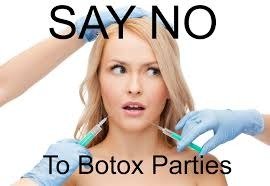In the UK, Botox has become a popular non-surgical cosmetic treatment, widely sought after for its ability to reduce wrinkles and fine lines. While typically administered in clinical settings, a concerning trend has emerged: Botox parties. These social gatherings, often hosted in private homes, salons, or spas, promise a relaxed and informal environment for cosmetic treatments. However, despite their allure, Botox parties raise significant concerns about safety, ethics, and legality. This article explores the concept of Botox parties, their risks, regulatory challenges, and the implications for both practitioners and participants.
What Are Botox Parties?
 Botox parties are social events where guests gather to receive Botox treatments in a group setting. Often hosted by individuals who may or may not be qualified practitioners, these events combine socializing with cosmetic procedures. Typically, a host organizes the event and invites friends or acquaintances, and a practitioner provides Botox injections at discounted rates to encourage group participation.
Botox parties are social events where guests gather to receive Botox treatments in a group setting. Often hosted by individuals who may or may not be qualified practitioners, these events combine socializing with cosmetic procedures. Typically, a host organizes the event and invites friends or acquaintances, and a practitioner provides Botox injections at discounted rates to encourage group participation.
The appeal of Botox parties lies in their informal atmosphere, affordability, and convenience. Guests may feel more comfortable undergoing treatments in the presence of friends, and the social element can make the experience seem less clinical and more recreational.
The Growing Popularity of Botox Parties in the UK
The rise of Botox parties in the UK can be attributed to several factors:
- Increased Accessibility of Botox
As Botox has become more mainstream, it is no longer viewed as a luxury treatment exclusive to celebrities. This democratization has made it more appealing to a broader demographic. - Social Media Influence
The culture of sharing cosmetic journeys on platforms like Instagram and TikTok has normalized Botox treatments, encouraging people to try them in group settings. - Cost Savings
Botox parties often offer discounted prices, making the treatment more affordable than in clinical settings. - Convenience
Hosting Botox parties in homes or informal venues eliminates the need for guests to travel to a clinic, adding to their appeal.
Legal and Regulatory Concerns
In the UK, Botox is classified as a prescription-only medicine (POM). This classification comes with strict regulations governing its prescription and administration:
- Qualified Prescribers
Botox can only be prescribed by a licensed medical professional, such as a doctor, dentist, or independent nurse or pharmacist prescriber. A face-to-face consultation is required to assess the patient’s suitability for treatment. - Supervision and Administration
While non-prescribing practitioners can administer Botox, they must do so under the supervision of a qualified prescriber who has assessed the patient and issued the prescription. - Venue Requirements
Botox is typically administered in clinical settings that meet strict hygiene and safety standards. Informal venues, such as private homes, are unlikely to meet these standards, increasing the risk of complications.
Risks Associated with Botox Parties
Despite their popularity, Botox parties pose several risks that should not be overlooked:
1. Lack of Medical Oversight
The informal nature of Botox parties often means that they are not overseen by qualified medical professionals. This increases the risk of improper dosage, incorrect injection techniques, and complications.
2. Inadequate Consultations
A proper Botox consultation involves a thorough assessment of the patient’s medical history, facial anatomy, and treatment goals. In group settings, consultations are often rushed or overlooked entirely, compromising patient safety.
3. Unsanitary Conditions
Unlike regulated clinics, the venues for Botox parties may not meet the necessary hygiene standards. Improper sterilization of equipment and a lack of infection control measures can lead to serious complications, such as infections or abscesses.
4. Peer Pressure and Impaired Judgement
The social environment of a Botox party can create peer pressure to undergo treatments, even if the individual has doubts or lacks understanding of the procedure. Alcohol consumption, often a feature of these events, can further impair judgement and increase the risk of complications.
5. Unqualified Practitioners
In some cases, the practitioner administering Botox at these parties may lack the necessary qualifications or training, leading to unsafe practices and poor outcomes.
6. Inability to Manage Complications
In a clinical setting, practitioners are equipped to handle adverse reactions, such as allergic responses or botulinum toxin migration. At a Botox party, access to emergency medical care may be limited, putting patients at greater risk.
Ethical Considerations
Beyond the legal and medical risks, Botox parties raise significant ethical concerns:
- Informed Consent
Ensuring informed consent is a cornerstone of medical ethics. At Botox parties, the informal atmosphere may prevent guests from fully understanding the risks and implications of the treatment. Alcohol is often available at these gatherings which clearly has huge implications for the entire process. - Pressure to Participate
The social setting can create pressure to undergo treatment, even if an individual is unsure or hesitant. This undermines the autonomy of the patient’s decision. - Prioritization of Profit Over Safety
Some practitioners participate in Botox parties to maximize profits, potentially compromising safety standards and ethical guidelines.
Regulatory Responses and Calls for Reform
The growing prevalence of Botox parties has prompted calls for stricter regulations to address the associated risks. Proposed measures include:
- Mandatory Licensing for Practitioners
Requiring all practitioners to obtain a license to administer Botox could help ensure that only qualified professionals provide treatments. - Venue Restrictions
Enforcing regulations that limit Botox administration to licensed clinics or medical facilities would reduce the risks associated with informal settings. - Public Awareness Campaigns
Educating the public about the risks of Botox parties and the importance of choosing qualified practitioners can help individuals make informed decisions. - Stricter Penalties for Non-Compliance
Introducing harsher penalties for practitioners who administer Botox illegally or fail to meet safety standards could deter unsafe practices.
How to Choose a Safe Botox Provider
For individuals considering Botox treatments, prioritizing safety is essential. Here are some tips to ensure a safe and effective experience:
- Verify Qualifications
Always ensure that the practitioner is a qualified medical professional with relevant training in aesthetics. - Choose a Reputable Clinic
Opt for a licensed clinic that adheres to hygiene and safety standards. - Ask for a Consultation
A thorough consultation is essential to assess suitability for Botox and discuss potential risks and benefits. - Avoid Social or Informal Settings
While Botox parties may seem convenient, they lack the safeguards of a clinical environment.
Conclusion
Botox parties in the UK represent a troubling trend that prioritizes convenience and cost over safety and professionalism. While they may offer a relaxed and social atmosphere, the risks associated with informal settings, rushed consultations, and unqualified practitioners are significant.
Just a simple Google search will bring up many companies which combine ‘Botox & Bubbles’ – actively encouraging (and often providing) combining alcohol with the administration of Botox – this has massive legal, ethical and safety implications and should always be avoided.
The UK’s regulatory framework for Botox administration is robust, but the rise of Botox parties highlights the need for stricter enforcement and public education. Patients should prioritize their safety by seeking treatments from qualified practitioners in reputable clinics. By understanding the risks and making informed choices, individuals can enjoy the benefits of Botox without compromising their health or well-being.

